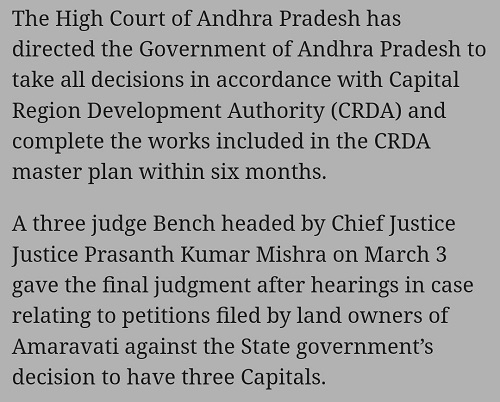[ad_1]

Introduction:
Brief background: Andhra Pradesh Capital:
In 2014, the Amaravati region was chosen as the site of the capital of Andhra Pradesh, the residuary State left after the creation of Telangana, but work was stopped after the present government regime took over.
The Andhra Pradesh Legislative Assembly passed the AP Decentralisation and Inclusive Development of All Regions Bill, 2020.
The Bill intends to give shape to the state government’s plan of having three capitals — executive capital in Visakhapatnam, legislative in Amaravati and judicial in Kurnool.
According to the government, multiple state capitals will allow the development of several regions of the state and hence leading to inclusive growth.
Idea of Decentralised Development:
Instead, present Chief Minister mooted the idea of ‘decentralised’ development, by which he meant that the State will have Amaravati as the legislative capital, while Visakhapatnam will be the executive capital, and Kurnool the seat of the High Court.
In a stern rebuff to the ‘three capitals’ idea of the present regime, a Full Bench of the State’s High Court has ruled that it cannot abandon the project to develop Amaravati as the capital city after over 33,000 acres had been given up by farmers and ₹15,000 crore sunk in it over development expenditure.
Present High court of Andhra Pradesh Judgement:
Holding the State government to its promise of developing the region into the capital city, it has directed the government to complete the required developmental work in Amaravati within six months.
As a consequential relief to the farmers who had given up their land for the specific purpose, the court has asked the State and the Andhra Pradesh Capital Region Development Authority to develop the surrendered land and deliver reconstituted plots to them within three months.
Multiple Capitals in a State:
- Several states in India have separate judicial capitalse. their High Courts in the different districts rather than in their state capitals because of the historical reasons.
- For example, in Uttar Pradesh, while the state capital is Lucknow, the High Court is at Prayagraj.
- Similarly, in Madhya Pradesh, while the state capital is Bhopal, the High Court is at Jabalpur and in Gujarat, while the state capital is Gandhinagar, the High Court is at Ahmedabad.
- However, Multiple capitals should not be used as an instrument for the development of the region.
- The development of the region can be brought by making an investment in the manufacturing and service sectors, bringing different policies benefiting the farmers and ease of doing business, development of the infrastructure, development of the social-cultural institutions such as universities, hospitals, etc.
Obstacles in different state capitals:
Separation of executive and legislative capital can be challenging. In the Parliamentary system of government, which has been adopted in India, functions of the executive and the legislature are closely connected. For example,
When the legislative assembly is in session, administrative officers are required all the time for the presentation of the bill, for briefing the ministers, etc.
When the legislative assembly is not in session, the decision making by the executive requires a lot of inputs from various sources including the legislators who are the representative of the people.
Decentralization in the State should take place by empowering the local governments i.e. the Panchayats and Municipal Corporations which were constituted after the enactment of the 73rd and the 74th Constitutional Amendment Act.
Critics argue the idea in terms of Political terms:
- In political terms, the decision to locate the three organs in different cities was possibly motivated by a wish to undo a key policy measure of the previous government regime, as well as negate speculative gains the erstwhile rulers may have allegedly made by choosing Amaravati.
- However, it was projected as a measure to decentralise governance and take the fruits of development to all parts of the State.
- After farmers approached the court, the government sought to render the matter infructuous by repealing its decentralisation law, the one that it enacted in 2020 for spreading the capital city and proposing ‘inclusive development’ of all regions.
- However, the Bench took note of the government’s intention to pursue its multiple capital cities plan and decided that it will adjudicate on the petitioners’ grievances.
- It held that the State legislature lacked the competency to shift the organs of the State.
- The verdict, if undisturbed by the Supreme Court, may put an end to attempts to shift the capital city out of Amaravati.
Conclusion:
That policies change with governments may appear acceptable in a democracy, but no court will allow a transformation so fundamental that rights and entitlements that accrued during an earlier regime are abandoned or frustrated.
A welcome feature of the verdict is that it has invoked the doctrines of constitutional trust and promissory estoppel to prevent a regime from going back on its promises to citizens.
It sends out a message that governance should not be buffeted by winds of political change or be held hostage to the passing whimsy of a particular regime.
[ad_2]

